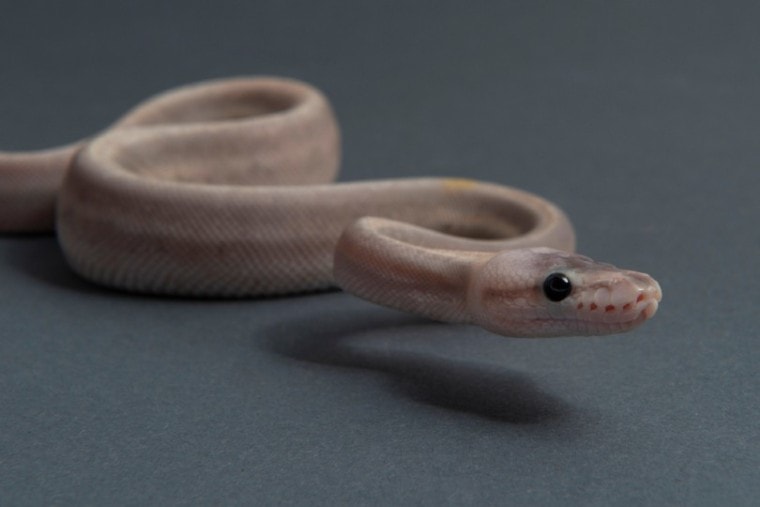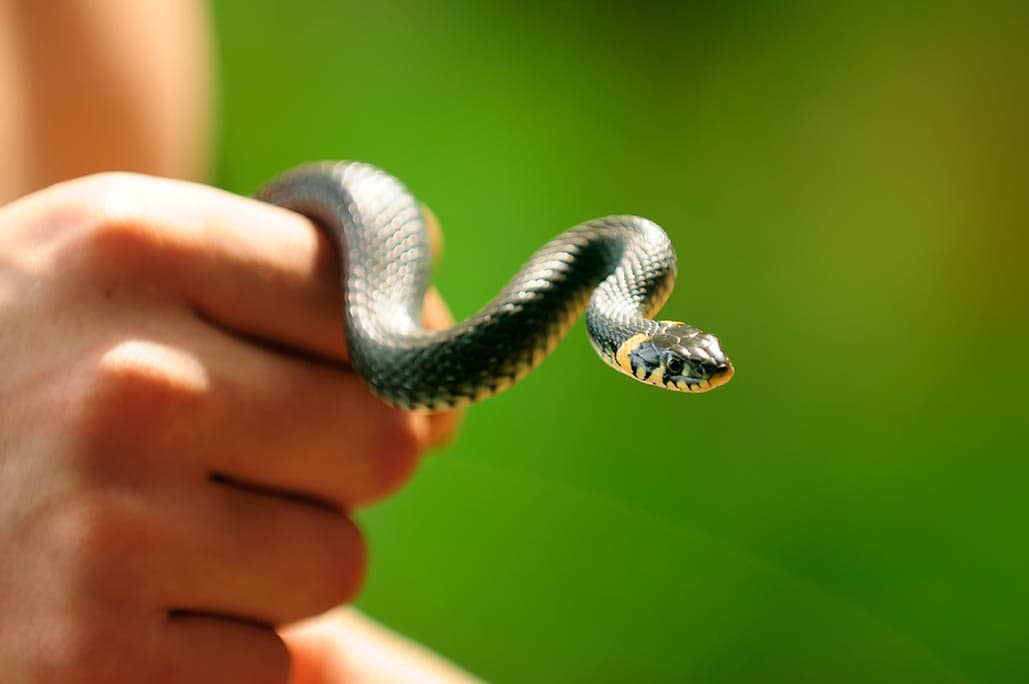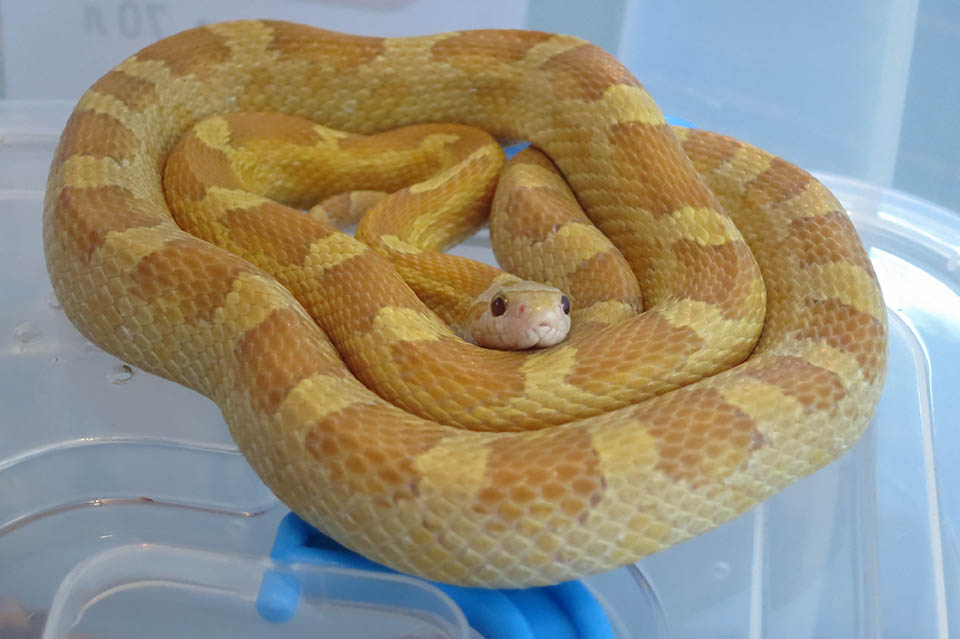
There are estimated to be over a thousand different Ball Python morphs, with that number growing every year. Breeders are continuously experimenting with different combinations to create the latest and most exciting morphs. Occasionally, they create a unique morph that becomes sought after by buyers around the world.
The Purple Passion is just one of these morphs, first appearing in 2007 and slowly gaining popularity ever since. This beautiful morph is unique and eye-catching indeed and high on the list of many reptile enthusiast’s dream morphs. If you’d like to know more about this gorgeous Python, read on for more info!
Quick Facts About the Purple Passion Ball Python Morph
| Species Name: | Python regius |
| Common Name: | Purple Passion |
| Care Level: | Moderate |
| Lifespan: | 20 – 30 years |
| Adult Size: | 4 – 5 feet |
| Diet: | Carnivore (mice and rats) |
| Minimum Tank Size: | 30 – 40 gallons |
| Temperature & Humidity | 75-80 degrees Fahrenheit on the cool side and 80-85 degrees Fahrenheit on the warm side; 50-60% humidity |
Do Purple Passion Ball Pythons Make Good Pets?
Ball Pythons are among the most popular pet snakes because they are generally easy to care for, docile and easy to handle, and great for beginners. They have long lifespans in captivity, though, up to 30 years in some cases, so they are a long-term responsibility. The Purple Passion morph is no different in care than any other Ball Python morph and makes a uniquely beautiful pet.
Appearance
The result of breeding a Mojave and Phantom morph, the Purple Passion morph has a creamy, lavender base color without any patterns on their belly or sides, although some do have broken up blotches with keyholes. They typically have a creamy white stripe running down their spine that beautifully contrasts their solid-colored body. The morph usually has dark brown or black eyes.
How to Take Care of Purple Passion Ball Pythons
Ball Pythons are among the most popular species of pet snakes due to their low care needs. They need a few simple requirements that when met, allow them to live long and healthy lives.
Habitat, Tank Conditions & Setup
Tank
You’ll need a solid glass enclosure of at least 30 gallons for your Ball Python, long enough to create the two temperature gradients that they need. But bear in mind that the tank shouldn’t be too big either. A tank that is too big (60 gallons or more) may stress out your snake and create problems with feeding, but it can be used if you place plenty of hides and foliage to take up the extra space.
Lighting
Ball Pythons need a regular day-night cycle, with a maximum of 12 hours of light per day. They’ll need both ambient lighting and a basking spot of around 85-90 degrees Fahrenheit, which can be provided with a heat lamp. This will also provide a great temperature gradient in their enclosure.
Heating (Temperature & Humidity)
Ball Pythons thrive in warm, moist habitats and will need a temperature of 75-80 degrees Fahrenheit on the cool side and 80-85 degrees Fahrenheit on the warm side, with a dedicated basking spot. This temperature gradient is essential to help them thermoregulate like they would naturally in the wild. They’ll need a humidity level of 50-60% — any lower will create shedding issues and any higher may result in respiratory infections. Spraying their enclosure once or twice a day will help keep the humidity correct, but a hygrometer is an inexpensive and simple way of keeping track of humidity accurately.
Substrate
One of the most favored substrates for Ball Pythons is aspen shavings, as they are inexpensive and readily available, and the light coloring easily reveals droppings for spot cleaning. Cypress mulch, coconut husk, and reptile bark are also great options, but you should avoid pine shavings or sand because these are easily ingested and absorb too much moisture.
| Tank Recommendations | |
| Tank Type | 30-40-gallon glass vivarium |
| Lighting | UV light |
| Heating | Temperature gradient, with a heating pad/tape on the bottom of enclosure and heat lamp for basking |
| Best Substrate | Aspen shavings |
Feeding Your Purple Passion Ball Python
Your Ball Python’s feeding needs will largely depend on their size, but you don’t need to feed them every day. Younger Pythons will need a meal once or twice a week, while adults only need a meal once every week or two, or once every 10 days. In captivity, live or frozen-thawed mice or rats are best because they are easy to find and provide complete nutrition for your snake. A good rule of thumb is to feed them a rodent that is around the same size as the midsection of your snake per meal.
| Diet Summary | |
| Fruits | 0% of diet |
| Insects | 0% of diet |
| Meat | 100% of diet — small/medium-sized rodents |
| Supplements Required | N/A |
Keeping Your Purple Passion Ball Python Healthy
Ball Pythons are generally healthy, hardy snakes, and with the right care, habitat, and diet, they suffer from few health issues. Make sure to keep a close eye on your snake for any infections, shedding issues, or behavioral changes, and take them for a complete physical examination once or twice a year just to be safe.
Common Health Issues
Two of the most common health issues in Ball Pythons are humidity-related: shedding issues and respiratory infections. If you notice any rapid change in behavior or loss of appetite accompanied by wheezing, lethargy, or nasal discharge, take them to a vet immediately.
Lifespan
The average lifespan for Ball Pythons in captivity is around 25 years, but they regularly live up to 30 years or more, with some specimens reaching up to 50 years in rare cases. In the wild, they usually only live around 10 years on average. They typically reach their full size at around 3 years old, with small gains in the years following.
Breeding
Ball Pythons have long reproduction lives that can last for their entire lives, and they are ready to breed at around 2 years old. They are generally easy to breed in captivity, leading to the wide variety of morphs that are available today. That said, breeding these snakes requires prior knowledge of the genetics and health of the individuals, as choosing the correct breeding pair is essential for the health of the offspring.
The eggs will need to be incubated and then hatched and raised separately, and you’ll need to buy additional equipment, which can get expensive, so this is a job best left to the experts.
Are Purple Passion Ball Pythons Friendly? Our Handling Advice
The Purple Passion morph, like all Ball Pythons, are friendly and docile snakes, but they still need to be handled gently and calmly to avoid injury and stress. Always use two hands to pick them up, and never pull them by the tail because this can cause severe spinal injuries. Use a loose grip to allow them freedom of movement, and keep handling to a maximum of 20-30 minutes per day.
You should avoid handling your Python during shedding and after meals, and you’ll want to wait until they are completely finished shedding and around 2 days after feeding before handling again.
Shedding & Brumation: What to Expect
Like all other snakes, Ball Pythons shed their skin as they grow, and you’ll notice their skin becoming dull and dark and their eyes milky and opaque before shedding. A healthy adult will shed their skin in one piece every 4-6 weeks, and the process typically takes 10-14 days in total.
In captivity, Ball Pythons do not brumate, but they may become more docile and eat less in winter months, even if they are not shedding or ill. Many breeders replicate brumation in captivity, which lasts around 1-3 months, but this is not necessary unless you are planning on breeding.
How Much Do Purple Passion Ball Pythons Cost?
Most common Ball Pythons go for as little as $50, but on average, they will cost $80-$100. The more exotic morphs naturally will cost more, with Purple Passion morphs going for $400-$500 on average.
Care Guide Summary
Final Thoughts
Docile, easy to care for, and beautiful, the Purple Passion Ball Python is a gorgeous snake and is one of the most unique morphs around. No matter the morph, these snakes are ideal for beginners due to their ease of care, but with lifespans of up to 30 years, they are certainly a massive long-term responsibility that should not be taken lightly.
Related Read:
- Mojave and Mystic Potion Ball Python Morphs: Facts, Pictures, Appearance & Care Guide
- How to Take Care of a Pet Snake
Featured Image Credit: photos2013, Shutterstock










